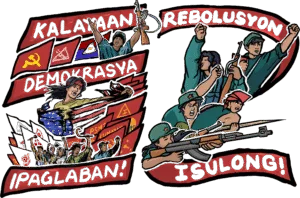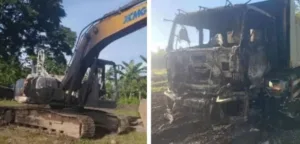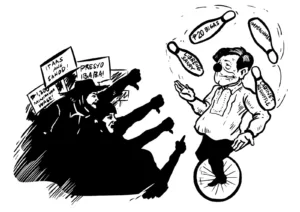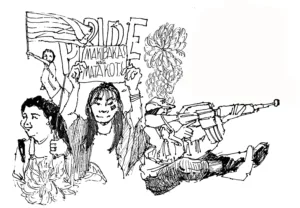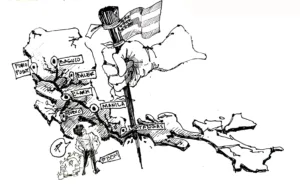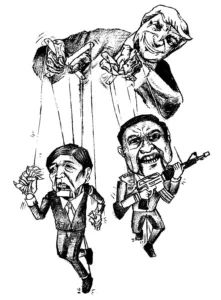Contribution of the Communist Party of the Philippines
to The 17th International Communist Seminar
Brussels, 16-18 May 2008
The Philippines is a semi-colonial and semi-feudal country, dominated by the US imperialists, the comprador bourgeoisie, the landlords and the bureaucratic capitalists. US imperialism and domestic feudalism are the main problems from which the masses of the people aspire to be liberated.
The Filipino working class, which emerged in the later period of Spanish colonial rule, has grown significantly in number and experience. But its further growth has been stunted because of the limitations in local industrialization and emphasis on raw material production and lately, on mere re-assembly plants, new plantations and businesses in the grip of foreign monopoly capitalism.
The Filipino working class suffers from extremely low wages and the whole nation suffers from lack of economic opportunity as a result of the repatriation of superprofits from the Philippines by foreign monopolies and loan payments to imperialist banks.
At this period of Philippine history, the old type of national democratic revolution no longer suffices. The era of imperialism has invalidated the leadership of the bourgeoisie. The class leadership in the Philippine revolution is now in the hands of the working class. The Communist Party of the Philippines (CPP) is the most advanced detachment of the Filipino working class leading the Philippine revolution forward.
Today, there is only one road that the Filipino working class must take and it is the road of armed revolution to smash the armed counterrevolution that preserves foreign and feudal oppression in the Philippines.
In waging armed revolution, the working class relies mainly on the mass support of its closest ally, the peasantry. The peasantry is the main force of the people’s democratic revolution. The peasant struggle for land is the main democratic content of the present stage of the Philippine revolution.
The working class and the Communist Party of the Philippines cannot accomplish both democracy and socialism at one blow. The Party must first achieve a new type of national democratic revolution, a people’s democratic revolution in the concrete semi-feudal and semi-colonial conditions of the Philippines before reaching the stage of socialist revolution.
The immediate general program of the Communist Party of the Philippines is a people’s democratic revolution and the long term maximum program is socialism.
The revolutionary armed struggle is the principal form of struggle because it answers the central question of the revolution which is the seizure of power. But the legal forms of struggle are important and indispensable even if these are secondary inasmuch as they are not the direct means for seizing political power.
The CPP could be re-established in 1968 and could launch the armed revolution in 1969 because since 1961 the proletarian revolutionaries had already developed the urban-based legal mass movement among the workers, women, youth and some sections of the petty-bourgeoisie, with an anti-imperialist and anti-feudal character.
The legal democratic mass movement from 1961 to 1968 enabled the newly re-established party to become nation-wide and deeply rooted among the masses. Since 1969, the CPP has co-ordinated the urban-based legal democratic mass movement and the rural-based armed revolutionary movement. Workers and educated youth have gone to the countryside to serve in the people’s army.
After the proletarian revolutionaries launched the revolutionary armed struggle as the principal form of struggle in 1969, they never ceased to pay attention to the necessity and due importance of further developing the urban legal mass movement. The process of developing the urban legal mass movement, drawing from it the cadres and most advanced mass activists from the ranks of workers and educated youth and deploying an increasing number of them to the countryside has continued.
Even as it is secondary to the armed struggle, the urban-based legal mass movement performs functions without which the national-democratic revolution and the armed struggle can be weakened or even defeated. It spreads the message of protest and revolution to the people on a nation-wide scale ahead of the capacity of the units of the people’s army to do so. It trains and tempers the legal cadres and mass activists and inspires them to further participate in the revolutionary mass movement, up to joining the armed struggle in the countryside.
Situation of the Filipino Working Class
Unemployment and under-employment run up to more than 40% of the labor force. For those who have jobs, wages remain low while prices of commodities and public services are constantly on the rise.
Workers’ rights to collectively bargain and to strike are severely curtailed. The Department of Labor and Employment (DOLE) often takes the side of the capitalists in labor disputes. Companies routinely resort to union busting. The police, military and company goons are employed to violently disperse workers at the picket-line. The courts are used to file criminal charges against striking workers and their leaders.
The average wage in the capital center of Metro Manila is 5 euros per day. This is very much lower when compared to the cost of living for a family of six of 11 euros per day. In the electronics, garments and textile industries where almost 90% of the workers are women, the wages are very low.
The big capitalists maximize their profits by enforcing speed-ups, by lengthening the working hours and by setting excessively high production quotas. The reactionary government has virtually granted business firms permission to violate the 8-hour working day. Employers are allowed to force their workers to render more than the regular 8-hour workday without overtime pay.
There is the case of Reynaldo Aguba, 29 years old and a contractual worker in Masuda Philippines who died after working continuously for 32 hours. The doctor who attended to him said that he died of exhaustion from work. Masuda is engaged in the production of auto parts for companies such as Honda Motors, Nissan Motors, Isuzu and Toyota Motors – all Japanese car companies.
In Fashion House Garments, 1,200 workers (95% of whom are women) work as permanent contractuals. They are often forced to work overtime for 24 hours. The management gives them Bonamine–an anti-dizziness drug to make them overcome fatigue and keep them awake.
In the Special Economic Zones, the “No union, no strike policy” is implemented.
The job security and wage conditions of all regular workers are undermined with the approval given by the “labor code” for employers to take in “apprentices” and “learners” at wages far below the minimum wage. Regular workers are being forced to resign or retire early only to be replaced by lower-paid workers.
Brutal methods are employed to suppress the exercise of labor rights including massacring striking workers as in Hacienda Luisita and Lepanto Mining where the reactionary army fired on and killed many workers. Trade union leaders and organizers are targeted for assassination.
Arousing, organizing and mobilizing the workers for the revolution
Our organizing work among the workers is in keeping with our Marxist-Leninist principle that the working class is the leading class in the Philippine revolution. We arouse and organize them based on their needs and demands and draw from their ranks the best elements into their own party, the Communist Party.
In conducting mass work among the workers, the first step is to do social investigation. We start by making friends with some workers in a given factory or line of work and holding a series of talks with them about their work and living conditions.
Our social investigation covers such things as job security, compliance with the minimum wage law, medical care, the system of promotions, the number of regular and non-regular workers, the departments or sections of work, the profits made by the company and the like.
A good knowledge of the reactionary laws pertaining to trade unions and workers is necessary. Actual work and living conditions of the masses of workers are so bad that certain provisions of these laws can be invoked and used to improve these conditions.
We try to be good pupils of the workers and at the same time, we inform the workers as to how they are being exploited and what they stand to gain by organizing a trade union and demanding compliance by the employers with provisions of the law that are beneficial to the workers.
From the first contacts we form the workers’ liaison group. This secret group can introduce to us more workers so that we can form a secret organizing group in every major part of that enterprise.
The next step is to form the workers’ organizing committee by drawing representatives or the best elements from the organizing groups. At every step, we deepen our social investigation and provide political education and appropriate instructions to the workers that we come into contact with and organize.
By the time that the committee is established, it shall have been ready to draw up the list of workers’ demands to which the majority of the workers are to be won over before the employers and his agents get wind of it.
The workers’ organizing committees as an underground force in the ranks of workers do not stop at pushing forward only economic demands otherwise we fall into reformism and economism. The workers’ organizing committees relate the economic struggle to the Party’s general line of people’s democratic revolution.
The workers’ organizing committee and its organizing groups are a good means for training and developing worker activists. At this stage our Party cadres already draw into the Party the advanced elements from the ranks of worker activists. Those who have completed the education course on the trade union work and the national-democratic revolution can be immediately introduced to Marxism, their very own class ideology to which they are very receptive.
Marxism-Leninism is easily and profoundly grasped by the workers once clarified simply, relevantly and step-by-step. It is after all the theory that touches the essence of the workers’ daily experience, that shows the leading role of their class in the revolution and that is drawn from the revolutionary experience of the world proletariat.
As soon as there are three or more Party members in a factory or line of work, a Party branch can be established. The ideological, political and organizational work of the Party branch and the groups under it in the enterprise is the best guarantee that revolutionary politics is in command of trade union work.
The workers’ organizing committee and its organizing groups are dissolvable upon the establishment of the Party branch and party groups within the enterprise and when all the worker activists are integrated into the structure of the trade union.
Some of our Party cadres may draw salaries and allowances from trade unions so as to devote their full time to trade union and political work. But Party members do not monopolize the high posts in the trade union. We allow the democratic broadness of the trade union; there can be good union leaders who cannot yet comply with the requirements of Party membership.
Trade unions under the effective leadership of the Party are not placed under only one chosen legal labor federation in consideration of the tactics of the enemy who may make a crackdown anytime. This is to prevent the enemy from singling out one nest for attack. Our trade unions can be independent or members of various labor federations. We determine the best possible status of each trade union.
The Party branch in an enterprise sees to it that Party members and other worker activists, with the help of the mass of their workers, do systematic revolutionary work in the workers’ communities.
Besides reaching the workers directly in a given factory or line of work, we can reach the workers who may belong to several workplaces by establishing community organizing committees and developing mass organizations of various types in workers’ communities.
By going deep among the masses of workers, we develop and strengthen further the subjective forces of the revolution, the organized workers and the revolutionary party of the proletariat, the Communist Party of the Philippines, among others. The proletarian revolutionary character of the Party is greatly enhanced by increasing the number of Party cadres and members of working class origin who can either carry on the revolutionary struggle in the urban areas or be shifted to the countryside, especially to the New People’s Army.
